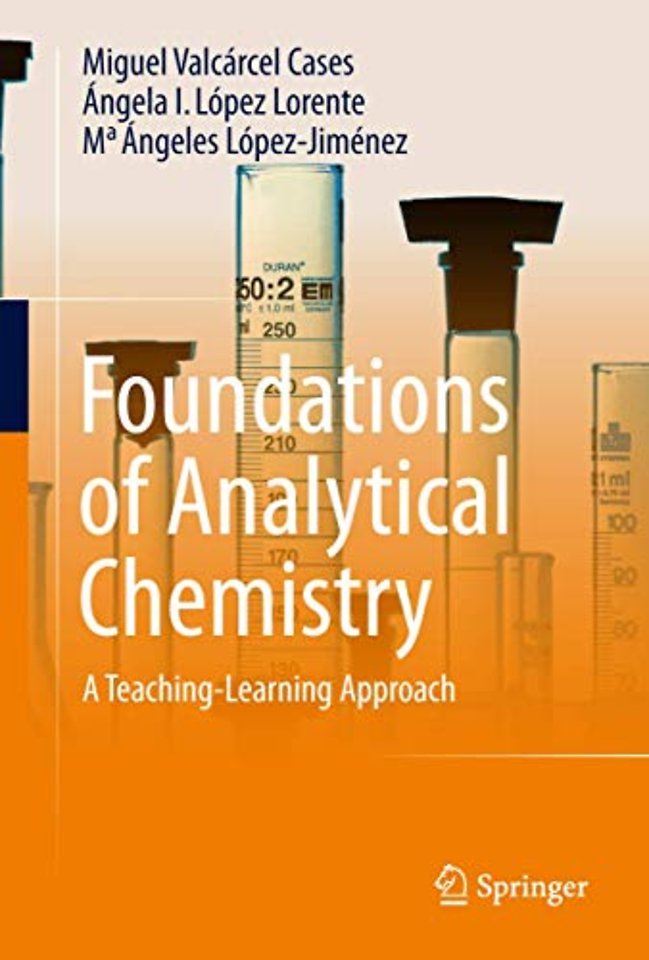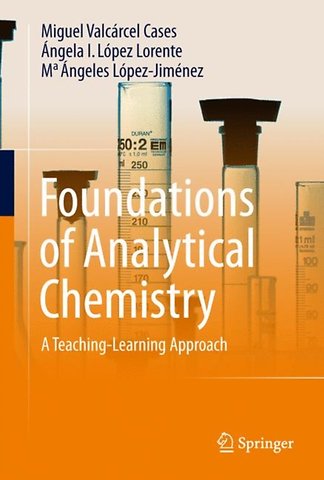


Miguel Valcárcel has been a Full Professor of Analytical Chemistry at the University of Córdoba, Spain since 1976.
Meer over de auteursFoundations of Analytical Chemistry
A Teaching–Learning Approach
Paperback Engels 2017 1e druk 9783319628714Samenvatting
This book offers a completely new approach to learning and teaching the fundamentals of analytical chemistry. It summarizes 250 basic concepts of the field on the basis of slides.
Each of the nine chapters offers the following features:
- Introduction: Summary. General scheme. Teaching objectives.
- Text containing the explanation of each slide.
- Recommended and commented bibliography.
- Questions to be answered.
- Slides.
A distinct feature of this novel book is its focus on the fundamental concepts and essential principles of analytical chemistry, which sets it apart from other books presenting descriptive overviews of methods and techniques.
Trefwoorden
analytische chemie kwalitatieve analyse kwantitatieve analyse traceerbaarheid chemische metrologie analytisch proces kwaliteitscontrole referentiematerialen analytische probleemoplossing analytische eigenschappen chemische informatie maatschappelijke verantwoordelijkheid kwaliteitsborging meetprecisie meetnauwkeurigheid instrumentele analyse screeningsmethoden klassieke analyse foutenanalyse chemische classificaties monstername dataverwerking analysetechnieken laboratoriumkwaliteit detectielimieten voorbereidende operaties ja/nee-respons signaalverwerking analytische metingen
Trefwoorden
Specificaties
Lezersrecensies
Over Ángela López-Lorente
Over Ma Ángeles López-Jiménez
Inhoudsopgave
U kunt van deze inhoudsopgave een PDF downloaden
1 Principles of Analytical Chemistry 3
1.1 Explanation of the Slides 4
1.1.1 Introduction to Part I (1 Slide) 6
1.1.2 Definitions of Analytical Chemistry (4 Slides) 7
1.1.3 Aims and Objectives of Analytical Chemistry (3 Slides) 11
1.1.4 Analytical Chemical References (4 Slides) 14
1.1.5 (Bio)chemical Information (4 Slides) 18
1.1.6 Conceptual and Technical Hierarchies (11 Slides) 22
1.1.7 Classifications (10 Slides) 32
1.1.8 New Paradigms of Analytical Chemistry (3 Slides) 43
1.1.9 Research and Transfer in Analytical Chemistry (2 Slides) 47
1.2 Annotated Suggested Readings. 49
1.3 Questions on the Topic (Answered in Annex 2) 50
1.3.1 An Abridged Version of the Chapter 51
2 Analytical Properties 53
2.1 Explanation of the Slides 54
2.1.1 Introduction (2 Slides) 56
2.1.2 The Chemical Metrological Hierarchy (3 Slides) 58
2.1.3 Errors in Analytical Chemistry (5 Slides) 61
2.1.4 Capital Analytical Properties (5 Slides) 66
2.1.5 Basic Analytical Properties (1 Slide) 71
2.1.6 Productivity-Related Analytical Properties (2 Slides) 105
2.1.7 Relationships Among Analytical Properties (6 Slides) 107
2.2 Annotated Suggested Readings 113
2.3 Questions on the Topic (Solved in Annex 2) 113
2.4 An Abridged Version of the Chapter 118
3 Traceability: Reference Materials 119
3.1 Explanation of the Slides 120
3.1.1 Introduction (1 Slide) 121
3.1.2 The Integral Concept of Traceability (4 Slides) 122
3.1.3 Types of Standards and Their Traceability (4 Slides) 126
3.1.4 Analytical Chemical Standards and Their Integration (10 Slides) 129
3.1.5 Specific Meanings of Traceability in Analytical Chemistry and Their Integration (10 Slides) 141
3.1.6 Traceability and Capital Analytical Properties (1 Slide) 150
3.2 Annotated Suggested Readings 151
3.3 Questions on the Topic (Answered in Annex 2) 152
3.4 An Abridged Version of the Chapter 154
Part II The Analytical Process
4 Generalities of the Analytical Process 157
4.1 Explanation of the Slides 158
4.1.1 Introduction to Part II (1 Slide) 160
4.1.2 Introduction to the Analytical Process (1 Slide) 161
4.1.3 Definition of Analytical Process (2 Slides) 162
4.1.4 General Steps of an Analytical Process (2 Slides) 165
4.1.5 Preliminary Operations of the Analytical Process
(23 Slides) 167
4.1.6 Measurement and Transducing of the Analytical Signal (1 Slide) 191
4.1.7 Data Acquisition and Processing (2 Slides) 193
4.2 Annotated Suggested Readings 195
4.3 Questions on the Topic (Answered in Annex 2) 195
4.4 An Abridged Version of the Chapter 197
5 Quantitative Analytical Processes 199
5.1 Explanation of the Slides 200
5.1.1 Introduction to Quantitative Analysis (4 Slides) 202
5.1.2 Expressing Quantitative Results (4 Slides) 206
5.1.3 Quantification Methods (3 Slides) 210
5.1.4 Calculable Methods (1 Slide) 213
5.1.5 Relative Quantification Methods (1 Slide) 226
5.2 Annotated Suggested Readings 229
5.3 Questions on the Topic (Answered in Annex 2) 229
5.4 An Abridged Version of the Chapter 232
6 Qualitative Analytical Processes 233
6.1 Explanation of the Slides 234
6.1.1 Introduction to Qualitative Analysis (2 Slides) 235
6.1.2 Analytical Screening Systems (3 Slides) 237
6.1.3 The YES/NO Binary Response (18 Slides) 240
6.1.4 Types of Qualitative Identification (1 Slide) 254
6.1.5 Classical Qualitative Analysis (8 Slides) 255
6.1.6 Instrumental Qualitative Analysis (7 Slides) 263
6.2 Annotated Suggested Readings 269
6.3 Questions on the Topic (Answered in Annex 2) 269
6.4 An Abridged Version of the Chapter 272
Part III Socio-economic Projection of Analytical Chemistry
7 Analytical Problem-Solving 275
7.1 Explanation of the Slides 276
7.1.1 Introduction to Part III (2 Slides) 277
7.1.2 Introduction to the Chapter (2 Slides) 279
7.1.3 The Concept of “Problem” in Analytical Chemistry (1 Slide) 281
7.1.4 An Integral Definition of “Analytical Problem” (5 Slides) 282
7.1.5 Elements of an Analytical Problem (1 Slide) 288
7.1.6 Steps of the Analytical Problem-Solving Process (9 Slides) 289
7.1.7 Concluding Remarks (6 Slides) 298
7.2 Annotated Suggested Readings 304
7.3 Questions on the Topic (Answered in Annex 2) 305
7.4 An Abridged Version of the Chapter 307
8 Analytical Chemistry and Quality 309
8.1 Explanation of the Slides 310
8.1.1 Introduction (2 Slides) 311
8.1.2 A General Approach to Quality (5 Slides) 313
8.1.3 Quality in Analytical Chemistry (4 Slides) 318
8.1.4 Quality Systems in Analytical Laboratories (7 Slides) 322
8.1.5 Analytical Quality Control (1 Slide) 329
8.1.6 Assessing Analytical Quality (6 Slides) 331
8.1.7 Supports of Analytical Quality Assurance (1 Slide) 338
8.1.8 Concluding Remarks (2 Slides) 340
8.2 Annotated Suggested Readings 342
8.3 Questions on the Topic (Answered in Annex 2) 344
8.4 An Abridged Version of the Chapter 345
9 Social Responsibility in Analytical Chemistry 347
9.1 Explanation of the Slides 348
9.1.1 Introduction (2 Slides) 350
9.1.2 The Concept of “Social Responsibility (9 Slides) 352
9.1.3 Social Responsibility in Science and Technology (2 Slides) 359
9.1.4 Social Responsibility in (Bio)Chemical Information (36 Slides) 361
9.2 Annotated Suggested Readings 388
9.3 Questions on the Topic (Answered in Annex 2) 389
9.4 An Abridged Version of the Chapter 390
Annex 1: Glossary of Terms 391
Annex 2: Answers to the Questions 411
Vaak samen gekocht
Anderen die dit boek kochten, kochten ook
Rubrieken
- advisering
- algemeen management
- coaching en trainen
- communicatie en media
- economie
- financieel management
- inkoop en logistiek
- internet en social media
- it-management / ict
- juridisch
- leiderschap
- marketing
- mens en maatschappij
- non-profit
- ondernemen
- organisatiekunde
- personal finance
- personeelsmanagement
- persoonlijke effectiviteit
- projectmanagement
- psychologie
- reclame en verkoop
- strategisch management
- verandermanagement
- werk en loopbaan







